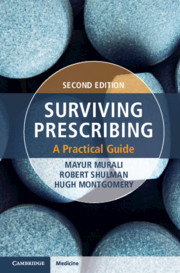Book contents
- Surviving Prescribing
- Reviews
- Surviving Prescribing
- Copyright page
- Contents
- Contributors
- Preface to the Second Edition
- Abbreviations
- Part 1 Introduction
- Part 2 Prescribing for Patient Groups
- Chapter 2 Prescribing in Renal Disease
- Chapter 3 Prescribing for Children
- Chapter 4 Prescribing for Older Patients
- Chapter 5 Prescribing in Pregnancy
- Chapter 6 The Basic Principles of Prescribing and Breastfeeding
- Chapter 7 Management of the Delirious (Acutely Confused) Patient
- Chapter 8 Prevention of Delirium Tremens and Management of Alcohol Withdrawal Syndrome
- Part 3 Emergency Prescribing
- Part 4 Gastrointestinal
- Part 5 Central Nervous System
- Part 6 Haematology
- Part 7 Surgery
- Part 8 Diabetes
- Part 9 Calculations
- Part 10 Interactions, Hypersensitivity and Contraindications
- Part 11 Infections and Other Important Topics
- Index
Chapter 3 - Prescribing for Children
from Part 2 - Prescribing for Patient Groups
Published online by Cambridge University Press: 08 June 2020
- Surviving Prescribing
- Reviews
- Surviving Prescribing
- Copyright page
- Contents
- Contributors
- Preface to the Second Edition
- Abbreviations
- Part 1 Introduction
- Part 2 Prescribing for Patient Groups
- Chapter 2 Prescribing in Renal Disease
- Chapter 3 Prescribing for Children
- Chapter 4 Prescribing for Older Patients
- Chapter 5 Prescribing in Pregnancy
- Chapter 6 The Basic Principles of Prescribing and Breastfeeding
- Chapter 7 Management of the Delirious (Acutely Confused) Patient
- Chapter 8 Prevention of Delirium Tremens and Management of Alcohol Withdrawal Syndrome
- Part 3 Emergency Prescribing
- Part 4 Gastrointestinal
- Part 5 Central Nervous System
- Part 6 Haematology
- Part 7 Surgery
- Part 8 Diabetes
- Part 9 Calculations
- Part 10 Interactions, Hypersensitivity and Contraindications
- Part 11 Infections and Other Important Topics
- Index
Summary
When it comes to prescribing, children are not ‘little adults’, and indeed, the dose and frequencies of medicines can change throughout childhood. While highlighting some basic principles for prescribing in children, this chapter explores why some drugs are unlicensed in paediatric patients, provides top tips for avoiding dosing errors and discusses how to improve compliance with drug therapy in younger patients. Readers are also advised on how best to report adverse drug reactions.
- Type
- Chapter
- Information
- Surviving PrescribingA Practical Guide, pp. 17 - 20Publisher: Cambridge University PressPrint publication year: 2020

